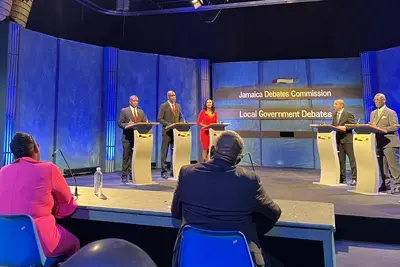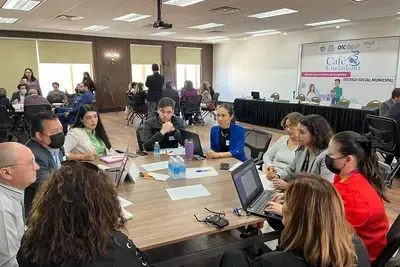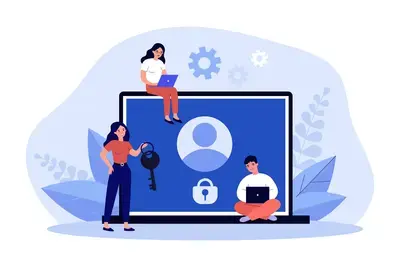Success Story
Rebuilding Haiti: NDI Country Director Describes his Earthquake Experience and Opportunities in its Aftermath
Gerard Latulippe, NDI’s resident director in Haiti, has been in Washington coordinating NDI’s efforts in response to the Jan. 12 earthquake. NDI has been supporting Initiative Committees that are mobilizing to support national and international relief efforts. Latulippe was in Port-au-Prince when the earthquake hit and describes the harrowing circumstances as well as NDI’s ongoing efforts.
Tell us where you were, what you were doing when the earthquake hit.
I was driving my car And you know, Port-au-Prince and Pétionville are in the hills, so suddenly my car projected onto another car that was parked on the street. Almost immediately I got out of the car and two houses collapsed in front of me. I stayed in the center of the street in order not to be hit by rocks that were falling from the houses. I was very lucky because I was not hit, but some of the people that were surrounding me were in fact hit by rocks.
Then after that, I decided that maybe the best thing to do would be to try to find out where is our visiting trainer, [Richard Mimeau, who had been in Haiti for the previous week to assist in our political party strengthening program. A Canadian with extensive experience in political party leadership as well as government, Richard] was [lodged] in the hotel Villa Créole.
Listen to Gerard talk about his experience immediately following the earthquake.
I decided to go to the Villa Créole. This small trip that would take normally 10 minutes took me two hours. There were rocks on the streets, people all over the place praying, crying, knocking on my car. We passed through a hotel that was in construction; it was completely collapsed. Finally I succeeded with some difficulty to reach the Villa Créole. It was partly collapsed, the center of Villa Créole collapsed, but our trainer, my friend, was safe.
What did you do that night at the hotel?
Then we had to pass a very difficult time during the night from 7 o’clock at night to 7 o’clock in the morning. We turned the parking lot of the Villa Créole into emergency care. There were two or three doctors from Doctors Without Borders that were there just by chance, and, with a few other volunteers, we provided first aid to Haitians who were coming in more and more numbers. Over the night we treated over 150 very deeply wounded Haitians with deep wounds in their skulls, broken legs or broken arms, wounds on their stomachs or feet, even burns. We had no proper equipment, so the owner of the hotel just took cushions and bed sheets [to try to make those injured more comfortable.] We took a knife to cut bed sheets, for example. We had peroxide mixed with water, some Q-tips or bandages, minimal things, a scissor to cut the hair of the people who were wounded in their head.
Listen to Gerard talk about his night after the earthquake.
Even the scissors broke at one point. Babies, four- to five-year-olds to old persons made up the injured – it was a really a very difficult experience. There was no electricity. We had two cars and used the light of the cars to light the parking lots. Some of us had flashlights because we needed to take the rocks out of the wounds and see where they were, so you would use a flashlight. On the side of the parking lot we could hear a huge noise coming from the city: people crying, or knocking on rocks where their family or beloved were stuck. This was really something to hear. At that moment we really realized that it was a very major earthquake.
How were you able to help these people with so few doctors and little medical expertise of your own?
At the beginning we were helping the doctors, and later we were doing things ourselves. The doctors were telling us what to do and sometimes we would worry that what we were doing was worse than doing nothing. But people were coming and bleeding and asking for help, so at least you do what you think you have to do: clean the wound and put on a bandage. So that’s what we were doing. There was nothing we could do for a broken leg. The doctors were taking the more important things. But, for example, we were taking branches to the doctor and splinting the leg with the help of the doctor.
Were you able to get any news or information about what was going on in Port-au-Prince?
Not a single piece of information. The day after, we were considering where to go. Some people there were telling us to go to the UN headquarters – we didn’t even know that the UN headquarters had collapsed. Richard Mimeau and I finally said, “No, we are going to go to the Canadian embassy.” We decided that we would go, and if we couldn’t go by car, that we would walk to the Canadian embassy. The roads were not blocked. We were able to go by car. As I was driving, Mimeau would go out and take the rocks out of the way so that I could drive. There were people all over the place and we finally arrived after an hour and a half or two hours when the trip would normally take 15 minutes.
Was the embassy in decent shape? Did you have to stay there?
There was some damage inside the embassy, so we could not work inside the embassy – the ambassador was working from outside. But they were quite well organized – when we arrived we were registered immediately.
Listen to Gerard tell about what he saw when he tried to return to his apartment.
The ambassador authorized me to try to go to my apartment with two Haitian staff and the nurse. I also tried to bring back some food for those at the embassy. That’s where it took, again, nearly two hours to go there and two hours to go back, and that’s when I saw the magnitude of the earthquake. Hundreds of people lying dead in the street – that’s where I saw the UN headquarters that had collapsed like a sandwich. Hospitals, I mean everything had been destroyed, a bus upside down on the rubble. I even saw one person that was sitting in this chair, like an office chair in the street, with blood, and three persons that were running and taking the chair, going into the street. I don’t know where because there were no hospitals – it was the type of vision of the end of the world. In my area the apartment building where I was living is the only one still standing. Everything else had been destroyed except that it was not possible to enter because it was cracked so much. They did not authorize us to go in if it was cracked, and anyways I wouldn’t have entered.
But the NDI office survived somehow?
Yes! It was some type of miracle. All around the NDI office is destruction. The NDI office is 100 meters from the Canadian embassy and the embassy was more impacted than our office. We reopened the office a few days after the earthquake. We shared the space with Internews for several weeks after the earthquake. Internews is another NGO with whom NDI has partnered in Haiti as well as other countries. They are the ones providing support to community radio stations across the country. They have a role to play for information related to aid, humanitarian aid and relief. So we are open.
How did NDI staff fare?
All of the staff survived but some with very difficult problems with their families. One staff member lost his family. Others lost houses and cars.
The staff is largely Haitian nationals. Are they still there? What are they doing?
All but a few of the staff are still in Haiti. We are still able to pay the staff, and we even started to hire some people that had worked for us in the past. NDI succeeded in reprogramming USAID funding that was originally designated for political parties to support community action groups with which NDI had worked for many years.
What kind of work are they doing?
NDI has had a very successful civic forum program in Haiti for years. Developed over more than a decade with NDI support, Initiative Committees (ICs) are present in 179 municipalities or villages – communes -- across the country and involve 35,000 Haitians and 3,500 civic organizations, including 400 women’s groups. Prior to the earthquake, the IC network organized their communities to carry out small community development projects, repair roads, facilitate medical treatment, provide potable water, build schools and promote transparency in government development projects. They are citizen committees – groups of about 11 people, representing other civic organizations. They are leaders in their communities. After previous natural disasters in Haiti, like hurricanes, a number of these groups have carried out needs assessments to assist in relief efforts for the communities.
Now these committees have started to take initiative in the aftermath of the earthquake and we are supporting them. Those initiative committees or ICs are working in five of the communes of Port-au-Prince and in other regions affected by the quake – and also outside of the city because there are many Haitians that have been displaced in other cities.
- In the greater Port-au-Prince areas of Bel Air, Solino and Carrefour, ICs helped families to evacuate their houses and establish camps for displaced people in schools and outdoor areas.
- In the earthquake-affected western city of Petit Goave, the ICs are working with the local authorities and NGO’s to facilitate the distribution of aid to the affected populations.
- The IC in the northern port of Cap Haitian is working with the municipal council to select the sites where thousands of people leaving devastated Port-au-Prince will be hosted, as many of the displaced do not have relatives in the region.
- In Gonaives, northwest of Port-au-Prince, a regional grouping of ICs is conducting a census of displaced people and the injured in hospitals and health clinics.
- Women’s organizations that make up many of the ICs are mobilizing to help earthquake victims in four cities: Martissant/Fontamara, Léogane, Petit-Goave and Marigot. In addition to helping women and children secure access to food, these groups are raising awareness on potential violence against women, prevention of HIV/AIDS and the need for special health and safety measures to protect women, such as separate sanitation facilities.
So a number of these citizen initiative committees are now working to establish community-level disaster relief coordination centers where they will liaise with the local authorities and humanitarian aid organizations. They will make an inventory of the aid, missing people and orphans of the region. They will make sure that aid reaches the most remote areas of the commune – to people who normally would not have access to it. They will help in the mitigation of conflicts and to disseminate information. Their efforts will support those of the Haitian government.
When you say NDI is supporting these committees, do you mean planning help? Or financially supporting?
Both, in fact. To open those centers, we are going to provide computers and cell phones, tents and kiosks. In each center, one NDI field coordinator will assist, but the local citizen groups, the Initiative Committees, are the ones who are going to take the lead. They are the ones who are going to work with local officials and humanitarian organizations to help identify local needs and collect and disseminate information on relief efforts.
I wonder if you could talk a little bit about the challenge of shifting focus? You talked about working almost as a doctor the day of the earthquake. Are NDI staff members working in Haiti having to do much different work from what they’re used to doing?
It’s a new focus but more because of the magnitude of the challenges. Our staff that was working with the initiative committees, they were doing similar things, but not at the magnitude that they are confronted with now. For example, in the aftermath of the hurricanes in Haiti in 2008, the initiative committees played a role. One role was that of watchdog, to help make sure that the aid is not diverted for corruption, that food is not sold at the market – they did that for the hurricanes. We have trained initiative committees about ways to address this type of situation and how to interact with authorities. So our staff is used to doing this.
What was your primary focus before the earthquake hit?
Elections. It was mainly a political party program. This was an election year and there were supposed to be legislative and local elections in February and a presidential election in November. Effectively we were training parties before the earthquake. We also did have a program for women’s political participation, funded by the Norwegian government. We are working with the Norwegians now to reorient our program toward citizen action in support of relief, with a strong focus on women.
Is that all on hold?
Yes. The legislative elections have been postponed and there is no time for an election at this point, but I personally believe that very shortly the issues of governance will be one of the major issues. NDI, I hope, will have a role to play to help strengthen governance so Haiti can start anew.
How soon can this work start, in rebuilding political institutions?
Well, at this point I think the priority is relief, but I really think and suspect that within the next few months governance will become a major issue.
Published February 23, 2010



